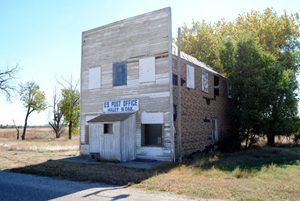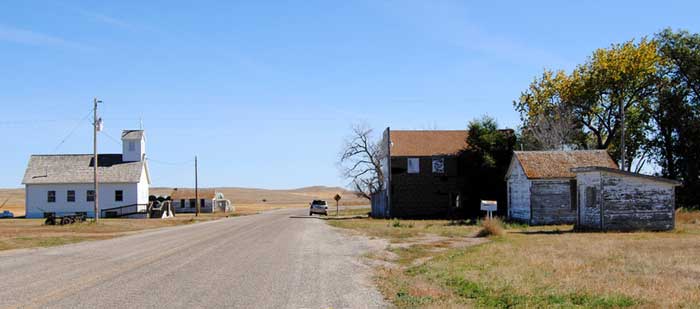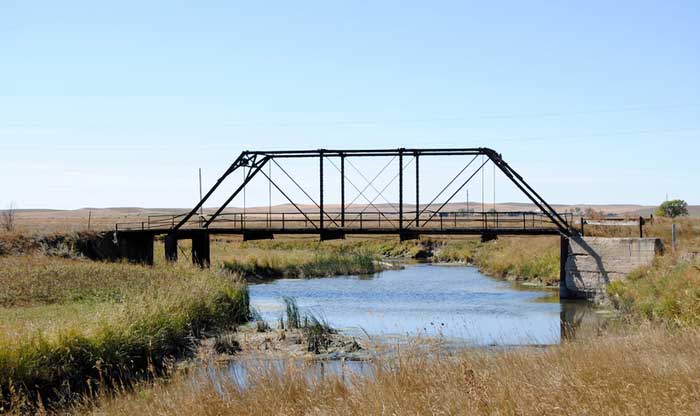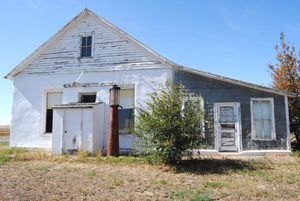The first mention of the area where Haley would later be founded came from Captain James L. Fisk, a promoter of western settlement, during his expedition across the Dakota Territory in 1864. Fisk would say that he had discovered a hill of gold along Deep Creek in Bowman County. However, his statement evidently didn’t lead to a great gold rush. Years later, though, a man named William Gay was prospecting for placer gold from the Grand River when he had some luck. It must have been fairly nominal because this discovery did not create a great following either. But, the prospector would not be forgotten. When Haley was founded in 1898, it was supposed to be named Galey in honor of the miner who had found placer gold in the nearby river more than a decade previous. However, a clerical mistake made by a postal official led it to be named Haley instead.
The town was founded when the area was still part of Billings County, but it later became part of Bowman County when it was organized in 1907. The first settler was Richard Ludlow Jackson, who first operated a post office out of his sod home and was engaged in ranching. The town was established because the first settlers believed that the Milwaukee Railroad would follow the Grand River. Ultimately, the railroad line would bypass the town by about 15 miles to the north. Still, the town flourished with several homesteaders in the area. Richard Jackson, the town’s founder, also built a hotel made of sod, which stood just across Scranton Road just west of Haley. The crumbled walls of the old hotel are still discernable. The hotel was described as a popular stopping place on the road from Dickinson to Camp Crook and the Black Hills country. It was also a stop on the Dickinson-Belle Fourche stage line. “Here, many a traveler enjoyed his genial hospitality, and his jovial manner and popularity won friends from far and near,” stated the Gascoyne Gazette.
In 1910, the Haley Bridge was built just southwest of the Haley townsite, spanning the Grand River. It was built by A.Y. Bayne of Minneapolis. Its iron frame rests on concrete footings and supports a double-planked roadway. The bridge, although no longer used for traffic, still stands. When the county asked for bids to dismantle the bridge in recent years, local citizens organized a historical association that purchased and preserved the span.
In 1911, a newspaper was established by a local pastor named E.A. Hobbs. The Haley Record began weekly publication on May 26, 1911. We were unable to determine how long the newspaper was published, but it continued to appear as an operating business in a 1916 Business Directory. The same directory mentions the town also had two churches – a Catholic and a Lutheran. It also had a daily stage that ran to Gascoyne for a fare of $1. Early Haley boasted a Roman Catholic church, which explains why a Haley Catholic Cemetery is on a hill just north of town. There is no trace of the church today.
The Haley Store, built by John Currey in 1900, was owned by Oliver Ellingson at some point during its early years. During this time, the Bores Head Saloon was located nearby. Local lore tells that the area cowboys often frequented the saloon on Saturday nights, shooting it up, so much so that there were numerous holes in the ceiling. Another story tells of a shootout on Main Street in front of the general store at high noon. The Cowboys fired both their weapons until they were empty, with neither landing a single shot. They then got on their horses and rode away, only to return the next Saturday night when neither could remember what they had even argued about. Haley Store was not immune to the Cowboys, either. On one occasion, a cowboy strolled into the store and demanded that Ellingson “dance” while he shot holes into the floor. Afterward, Ellingson was known to tell the story, often taking off his shoe and revealing a missing toe.
Other businesses and buildings also sprang up, including a hotel, a bank, a butcher, a blacksmith, a doctor, and a barber.
On August 3, 1915, town founder Richard L. Jackson, who was more familiarly known in Haley as “Uncle Dick Jackson”, died at the age of 73. The Gascoyne Gazette would say of him: “The passing of this grand old pioneer casts sorrow throughout this part of the country, as there was no man better known than Uncle Dick Jackson. He was one of nature’s noblemen in its truest sense – brave, generous, manly. His was a soul of honor and his friends and friendships were sacred to him.” He was buried in the cemetery on his homestead.
In 1918, Haley was struck, like the rest of the world, by the terrible Flu Pandemic, which killed somewhere between 20 and 40 million people worldwide. Haley’s town doctor, 35-year-old John Poppe diligently ministered to patients during the outbreak, and, caught the deadly virus himself, dying on October 27, 1918.
In 1921, a fire raged through the village, destroying several buildings, including the post office, which was then moved into the old hotel.
In the 1940s a Lutheran church was moved to Haley from South Dakota. It remains in Haley today, and even though the town boasts a population of only two people, it continues to have an active congregation. Haley’s post office closed in 1965, never to reopen. Two years later, in 1967, the Haley Store, considered the oldest building in the county, also closed. The Anfinnsons were the last proprietors of the store.

This building served as a hotel at one time and later held the post office. By Kathy Alexander, 2011.
© Kathy Weiser/Legends of America, updated April 2024.
Also See:
North Dakota Ghost Town Gallery



